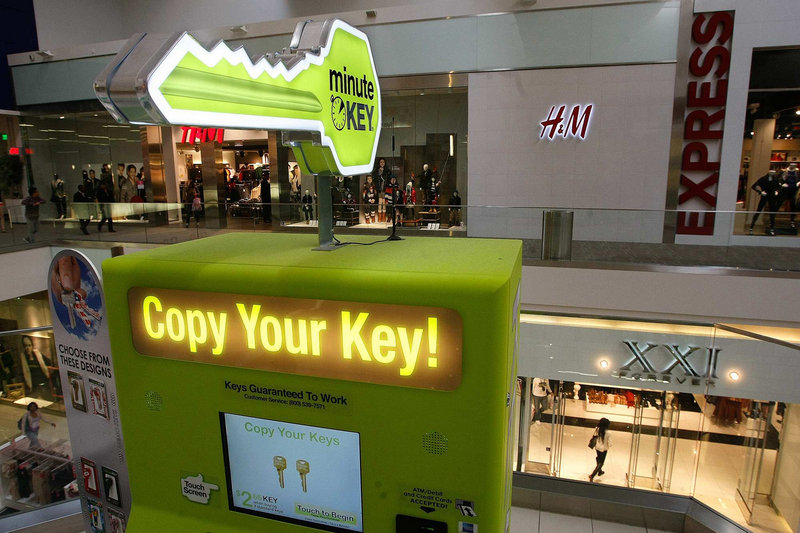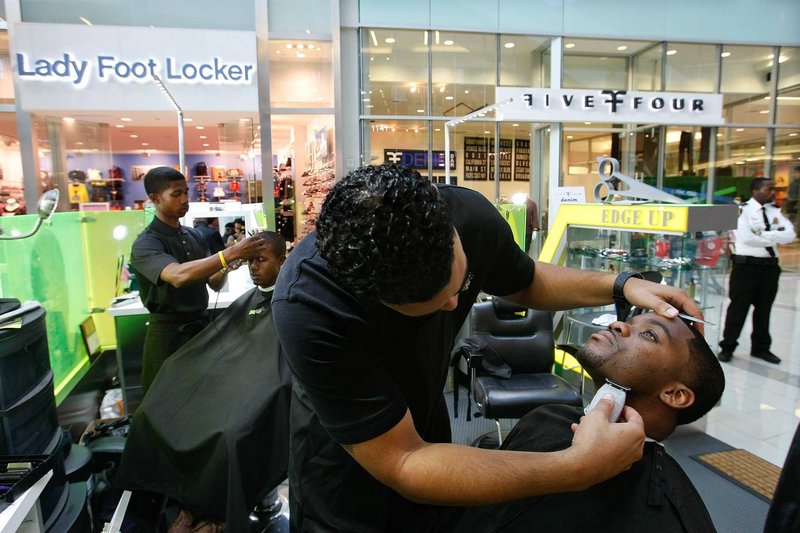LOS ANGELES – Going to Los Angeles’ Westside Pavilion mall is a Friday afternoon ritual for Jenny Ouchi and her 8-year-old son, Will. But shopping isn’t usually on the agenda.
Ouchi drops Will off at Music Stars & Masters on the second floor, where he takes private piano lessons. During the half-hour session, Ouchi, 38, runs errands in the Los Angeles shopping center, such as getting her nails done or mailing a letter at the in-mall post office.
“It’s definitely a timesaver,” said Ouchi, a pediatrician who lives on the Westside. “The more things I can do in one trip, the better.”
Malls are looking more and more like Main Street.
With retail spending gradually shifting to the Internet, the enclosed shopping centers best known for department stores, teen apparel chains and shoe shops are increasingly adding the kinds of services people usually find closer to home.
So instead of all-day spending sprees, consumers are showing up to drop off prescriptions, get their teeth whitened, have keys made or work out at the gym.
Westside Pavilion, for instance, offers child development classes, shoe and jewelry repair, a hair salon and a massage shop. A branch of National University, a private nonprofit college, is slated to open soon. Music Stars & Masters recently expanded, opening a second location in the mall last month for birthday parties and group lessons.
That’s just the beginning. Visit any Southern California shopping center and there’s a dizzying array of new businesses: day-care and tutoring centers, cooking schools, grocery stores, florists, Ticketmaster branches and shops offering eyelash extensions, car detailing, handbag repair, career counseling and pet adoptions. There are even dialysis centers and dental offices.
National chains once mostly found in stand-alone big-box locations, such as Target and Costco stores, also are moving in.
“Nontraditional tenants in a retail property is really the wave of the future,” said Michael Niemira, chief economist at the International Council of Shopping Centers. “We’ve hit the saturation point of retail.”
Non-retail and non-restaurant businesses make up about 17 percent of leasable regional mall space, but that number is expected to grow significantly and could reach 25 percent within a decade, he said.
The rise of the hybrid shopping center was sped up by the retail industry’s troubles during the recession, as malls around the country looked for unconventional tenants to fill shuttered storefronts, often by offering reduced rents and other favorable lease terms. The growth of online shopping has also caused many retailers to downsize or close underperforming bricks-and-mortar locations, opening spaces for newcomers.
The changes rankle some merchants, such as Sara Dovan, co-owner of Traffic, a high-end clothing boutique at the Beverly Center. The L.A. mall is one of the few in the area to resist adding general-purpose services and stores, which Dovan said were “not appropriate at all” for upscale centers.
“I pray to God they will never open those shops in the Beverly Center,” she said. “It starts to feel like bazaar shopping, not luxury shopping.”
Although malls may be less exclusive these days, the mixed offerings have been a boon to busy consumers and have led to impulse purchases as well.
Diane Henry, 62, recently had an hour to get ready for a fundraising event and drove to Westfield Culver City in California to get her eyebrows threaded at Shapes Brow Bar and buy a shawl from Macy’s. At the department store’s checkout counter, Henry noticed a jewelry display and mused that a new pair of earrings would go well with her outfit.
“Now I’m doing something I wasn’t necessarily planning on, and that’s how they get you,” said Henry, a real estate agent from Baldwin Hills, Calif. Her one disappointment? “I wish they had a car wash. I would have been set.”
Service-oriented shop owners, meanwhile, get to harness malls’ foot traffic. Many say business has soared and they don’t need to advertise because their locations alone are enough to attract customers.
After years co-owning three L.A.-area barbershops, all in stand-alone street locations, barber Percy Souder Jr. became frustrated by the periods of downtime between clients.
So when it came time to open a fourth shop, he chose a 260-square-foot kiosk in Westfield Culver City. Edge-Up barbershop, sandwiched between a Best Buy, Lady Foot Locker and teeth-whitening station in the middle of the mall, opened three months ago and quickly became Souder’s busiest shop. He recently signed a lease for another mall space, at Westfield West Covina.
“I figured instead of waiting for the people to come to me, I’d go to the people,” Souder said as he snipped a client’s hair in view of passing shoppers. “I’ve stolen many a client from his barber, and that’s not because I’m so much better than everyone else, but because I’m convenient.”
LaJuan Davis, 52, was picking up job applications at the mall recently when he came across Edge-Up. The sight of the electric-green kiosk piqued his curiosity, and he circled back to take a second look. But the downtown L.A. resident was initially skeptical of getting his hair cut in public.
“You don’t want to take your Benz to a Volkswagen” repair shop, he said dubiously, before deciding to give the barbershop a chance. Fifteen minutes later, a freshly shorn Davis emerged. “Fantastic,” he said. “I’m very satisfied.”
Mall executives say although they’ve become more open to atypical tenants, they’re careful to make sure the balance of offerings is right.
“If our shoppers identify with a tattoo parlor, chances are, we’ll either pursue one or an entrepreneur will come to us,” said Randy Brant, executive vice president of real estate at mall operator Macerich, which owns Westside Pavilion and Santa Monica Place. That said, “we have to be fashion first — any regional mall that has lost its fashion sense is dead.”
They’ve had to draw the line in some cases.
“We get calls every day to do medical marijuana facilities,” said Larry Green, senior vice president of development for Westfield. “We haven’t gone there yet.”
Copy the Story Link
Send questions/comments to the editors.




Success. Please wait for the page to reload. If the page does not reload within 5 seconds, please refresh the page.
Enter your email and password to access comments.
Hi, to comment on stories you must . This profile is in addition to your subscription and website login.
Already have a commenting profile? .
Invalid username/password.
Please check your email to confirm and complete your registration.
Only subscribers are eligible to post comments. Please subscribe or login first for digital access. Here’s why.
Use the form below to reset your password. When you've submitted your account email, we will send an email with a reset code.